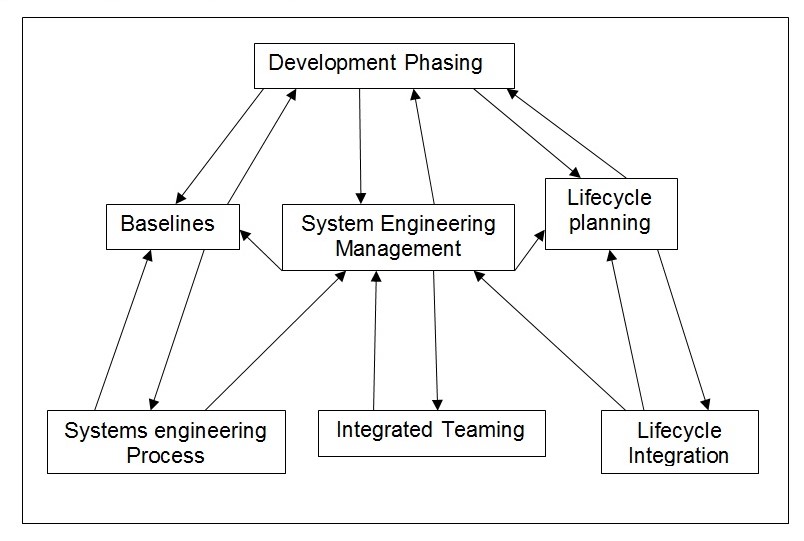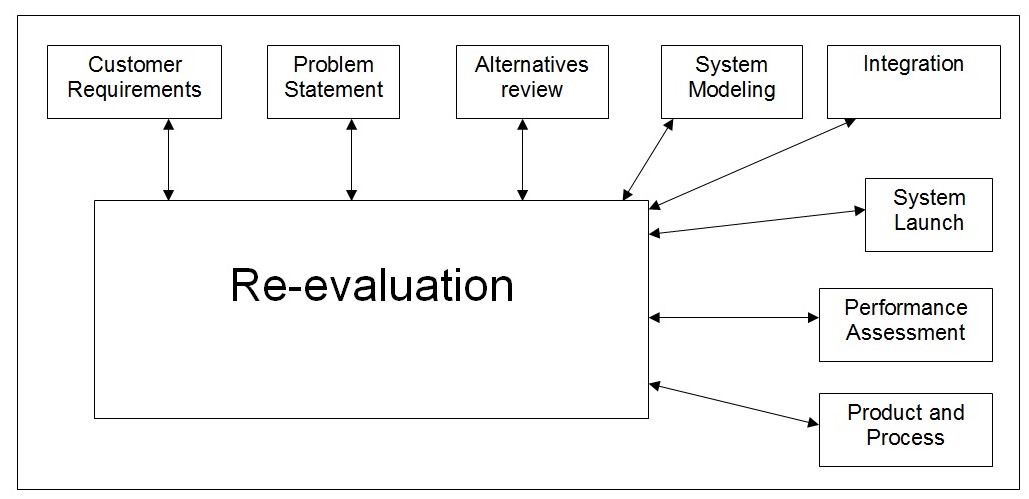Introduction
System engineering is generally required for the proper arrangement of the managed system and for professional risk management practices. Considering the fact, that the necessity to improve the entire performance of any system is required for the smoother decision making and problem solving processes, the system engineering practices are generally associated with the factors of risk management and technical improvement of the techniques and principles of system management. The aim of the paper is to review the aspects of system engineering and application of the technical aspects towards the principles of engineering. Moreover, the aspects of the system engineering necessity will be regarded in the context of system quality.
Technical Risks
As it is generally stated in the fundamentals of system engineering, the proper engineering decreases the possible technical risks essentially. In the light of this statement, it should be emphasized that the necessity to manage the system engineering is of high importance for any technical system. On the other hand, the system engineering may violate the entire performance, if the possible mistakes are not considered during the engineering process, the failure is inevitable. Thus, as it is emphasized Andriole and Adelman (2005, p. 267), the original value of system engineering is the proper planning and risk management:
The traditional scope of engineering embraces the design, development, production and operation of physical systems, and systems engineering, as originally conceived, falls within this scope. “Systems engineering”, in this sense of the term, refers to the distinctive set of concepts, methodologies, organizational structures (and so on) that have been developed to meet the challenges of engineering functional physical systems of unprecedented complexity. The use of the term “systems engineering” has evolved over time to embrace a wider, more holistic concept of “systems” and of engineering processes. (Andriole and Adelman, 2005, p. 267)
In the light of his statement, all the arguments, directed at explaining the usefulness of the system engineering is closely associated with the multi angled approach of the entire system. Thus, as it should be emphasized within the system engineering concept, the original value of the system engineering is covered in the interdisciplinary review of the possible problems. Thus, considering all the possible aspects of the system functioning, system engineering is required for the analysis of the entire lifecycle of the system, thus, analyzing all the possible risks and failures, which may be caused by the mistakes in long term or short term planning.
Additionally, it should be emphasized that the ability to describe the risk of failure also requires some experience of engineering. In the light of this statement, there is strong necessity to mention that it will be meaningless to make an accent on a possible percentage of risk or success in the beginning of the project implementation. Thus, the technical team will be attempting to overcome the possible problems, nevertheless, it will remind challenging the uncertainty and innovations, rather than managing risks.
Quality Improvement
The quality of the resultant system, as well as the entire performance of the system and its effectiveness strongly depend on the planning process and the values of system management from the perspectives of strategic planning and proper resource management. Originally, the system engineering approach is able to improve the quality of the system by considering all the possible aspects of system performance and the scope of system activities. Thus, in accordance with the chart, the scope of the system aspects, which are regarded by system engineering approach, should be properly considered in order to improve the performance of the system and increase the quality level.

In accordance with the given chart, it should be emphasized that the scope of the activities, which any system entails, should be considered by the engineering approach in order to improve the quality. Thus, as it is stated in McGraw and Harbison (2007, p. 154):
One way to understand the motivation behind systems engineering is to see it as a method, or practice, to identify and improve common rules that exist within a wide variety of systems. Keeping this in mind, the principles of Systems Engineering — holism, emergent behavior, boundary, et al. — can be applied to any system, complex or otherwise, provided systems thinking is employed at all levels. Besides defense and aerospace, many information and technology based companies, software development firms, and industries in the field of electronics & communications require Systems engineers as part of their team.
Thus, system engineering should be feature with the effective team work in order to provide the sufficient level of quality improvement tools. Considering the fact, that all the quality improvement techniques depend on the values of proper planning and effective team work, it should be stated that the system engineering is similar to strategic management in business sphere. Consequently, this presupposes not only monitoring of the system performance, but also the correct system resource management and accurate coordination of system components’ activity.
Tailoring Standards
Tailoring standards is important in order to adapt the entire system towards the working environment and for ensuring the possible risks and failures of the system, caused by the inconsistency of the standards and the values of the system. Additionally, all the changes and tailoring processes are performed in order to adjust the set of requirements. The outline process of defining the set of standards, and tailoring them in accordance with the requirements of the system is not a simple assignment, as it generally requires the collective efforts from the side of technical team and the mutual determination to reach the productive cooperation by the contracting sides: customer and contractor. Thus, when all the requirements are understood, the system engineering team should refine all the necessary details and define the best course of the project implementation. Starting from this moment the trade studies are implemented and the values of the traditional engineering encouragement system. A weighted choice of the working criteria will be required. The final stage of the outlining system is described by Boville (2000, p, 71):
The trade study in turn informs the design which again affects the graphic representations of the system (without changing the requirements). In an SE process, this stage represents the iterative step that is carried out until a feasible solution is found. A decision matrix is often populated using techniques such as statistical analysis, reliability analysis, system dynamics (feedback control), and optimization methods.
Originally, the outlining system of standard tailoring is closely associated with the aims and purposes of both sides, thus, there is strong necessity to regard the planning process of the engineering system:

In the light of this statement, the standard tailoring is generally based on the constant re-evaluation of the entire performance system and assessment of the system engineering strategy. Thus, the tailoring process should be regarded from the position of tendering / contract process, which is required for defining the aims and requirements of both sides. Originally, the entire process is based on the estimation of the system potential and perspectives of the further performance effectiveness.
System Prototype
The system prototype is generally used for the definition of the system performance outline and the aspects of the environment, within which the completed system will operate. The fact is that, the prototype is the required blueprint of the system engineering process, as independently on the further variations, the system performance prototype defines the key steps of project implementation, and helps to define the existing and required characteristics of the project. On the other hand, the prototyping is required for offering the customer the accomplished solution of the required technical assignment. Originally, customers often do not know their actual requirements, thus, prototyping of the system is required for showing them the actual necessity of the system engineering implementation. Thus, in accordance with Andriole and Adelman (2005, p. 412), the following statement should be emphasized:
Systems Engineers must enter the customer’s environment and find out how the customer will use the system. We must exceed, not merely meet, customer expectations. Flexible designs help identify aspects that might have been overlooked. Talking to your customer’s customer and your supplier’s supplier can be very useful. The terms customer and stakeholder include anyone who has a right to impose requirements on the system: end users, operators, owners, bill payers, regulatory agencies, etc. are useful for seeing how the system fits into the customer’s enterprise.
Considering the fact, that prototype and the completed project are often too different, it should be emphasized that the key task of the prototype is fulfilled. Thus, when the prototype is shown to a customer, and the key requirements are defined, customer starts realizing the key values of the project and the principles of system engineering. Then, amendments are offered, and the customer is deeply involved into the planning process. This means that the customer is interested in successful cooperation, and is able to formulate the aims and requirements for the project. Otherwise, the misunderstandings are inevitable. That is why there is strong necessity to use prototyping as the effective communication tool, for defining the requirements of the customer
Conclusion
Finally, it should be emphasized that system engineering is the effective and universal project management system. From the technical point of view, the engineering of the system provides numerous opportunities, such as process improvement, quality assurance and risk decrease tools. In the light of this fact, it should be stated that the system engineering, if applied properly, defines the key values of the project requirements, and helps to arrange the required communication level with the consumer. On the other hand, engineering system approaches may be used for defining the standards of the project, and evaluating the possible outcomes of the improper assessment of the standards and project requirements.
Reference List
Andriole, S., & Adelman, L. 2005. Cognitive Systems Engineering for User-Computer Interface Design, Prototyping, and Evaluation. Lawrence Erlbaum Associates. Hillsdale, NJ
Boville , D. 2000. Managing Technical Risk Understanding Private Sector Decision Making on Early Stage Technology-based Projects. National Institute of Standards and Technology, Harvard University, John F. Kennedy School of Government. Gaithersburg
McGraw, K. L., & Harbison, K. 2007. User-Centered Requirements: The Scenario-Based Engineering Process. Lawrence Erlbaum Associates. Mahwah, NJ